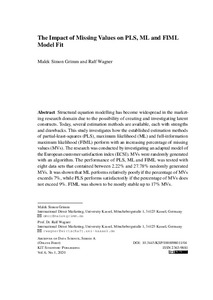The Impact of Missing Values on PLS, ML and FIML Model Fit
| dc.date.accessioned | 2021-08-20T13:37:47Z | |
| dc.date.available | 2021-08-20T13:37:47Z | |
| dc.date.issued | 2020 | |
| dc.identifier | doi:10.17170/kobra-202107074257 | |
| dc.identifier.uri | http://hdl.handle.net/123456789/13142 | |
| dc.language.iso | eng | eng |
| dc.rights | Namensnennung - Weitergabe unter gleichen Bedingungen 4.0 International | * |
| dc.rights.uri | http://creativecommons.org/licenses/by-sa/4.0/ | * |
| dc.subject.ddc | 330 | |
| dc.title | The Impact of Missing Values on PLS, ML and FIML Model Fit | eng |
| dc.type | Aufsatz | |
| dcterms.abstract | Structural equation modelling has become widespread in the marketing research domain due to the possibility of creating and investigating latent constructs. Today, several estimation methods are available, each with strengths and drawbacks. This study investigates how the established estimation methods of partial-least-squares (PLS), maximum likelihood (ML) and full-information maximum likelihood (FIML) perform with an increasing percentage of missing values (MVs). The research was conducted by investigating an adapted model of the European customer satisfaction index (ECSI). MVs were randomly generated with an algorithm. The performance of PLS, ML and FIML was tested with eight data sets that contained between 2.22% and 27.78% randomly generated MVs. It was shown that ML performs relatively poorly if the percentage of MVs exceeds 7%, while PLS performs satisfactorily if the percentage of MVs does not exceed 9%. FIML was shown to be mostly stable up to 17% MVs. | eng |
| dcterms.accessRights | open access | |
| dcterms.creator | Grimm, Malek Simon | |
| dcterms.creator | Wagner, Ralf | |
| dc.relation.doi | doi:10.5445/KSP/1000098011/04 | |
| dc.subject.swd | Maximum-Likelihood-Schätzung | ger |
| dc.subject.swd | Verbraucherzufriedenheit | ger |
| dc.subject.swd | Marktforschung | ger |
| dc.subject.swd | Methode | ger |
| dc.type.version | publishedVersion | |
| dcterms.source.identifier | issn:2363-9881 | |
| dcterms.source.issue | No. 1 | |
| dcterms.source.journal | Archives of Data Science, Series A | eng |
| dcterms.source.volume | Vol. 6 | |
| kup.iskup | false |
Dateien zu dieser Ressource
Das Dokument erscheint in:
-
Publikationen [38]


